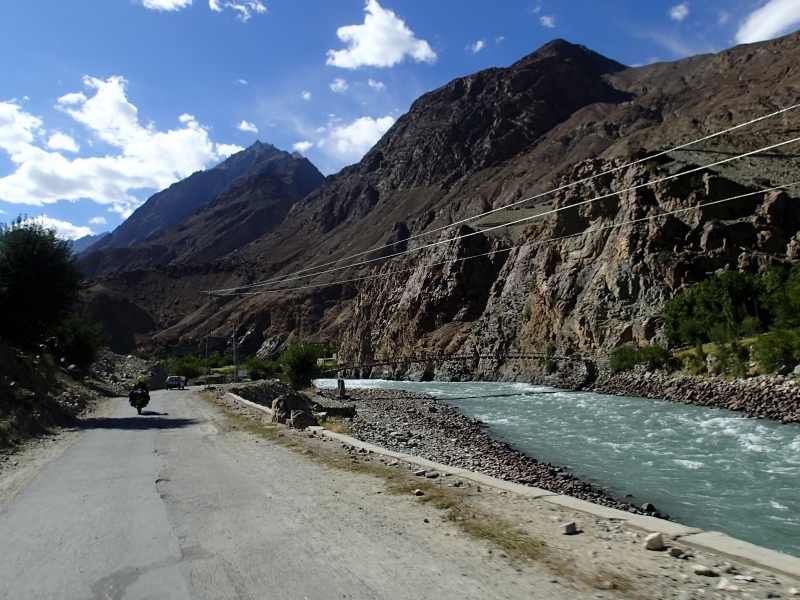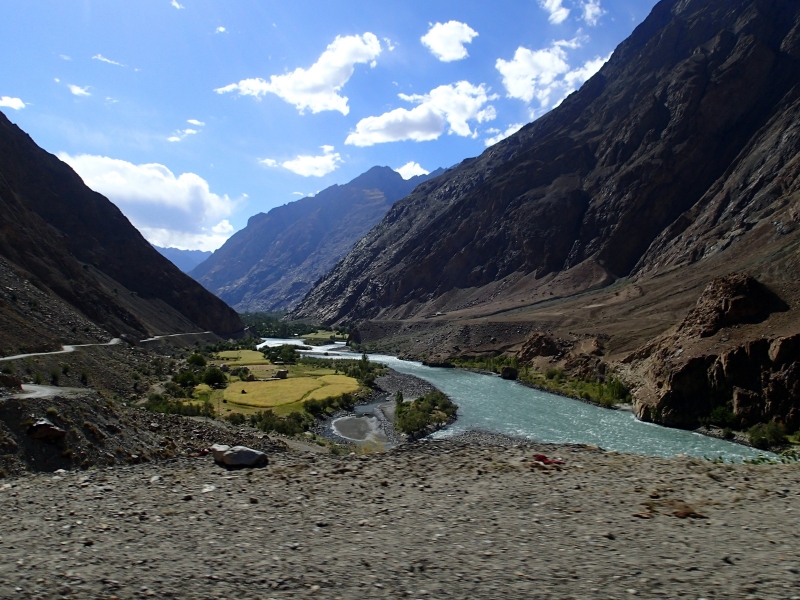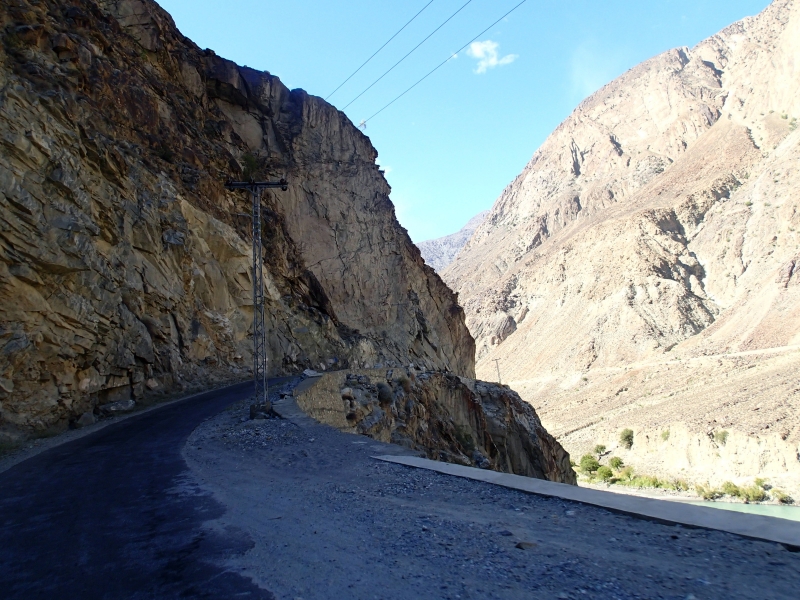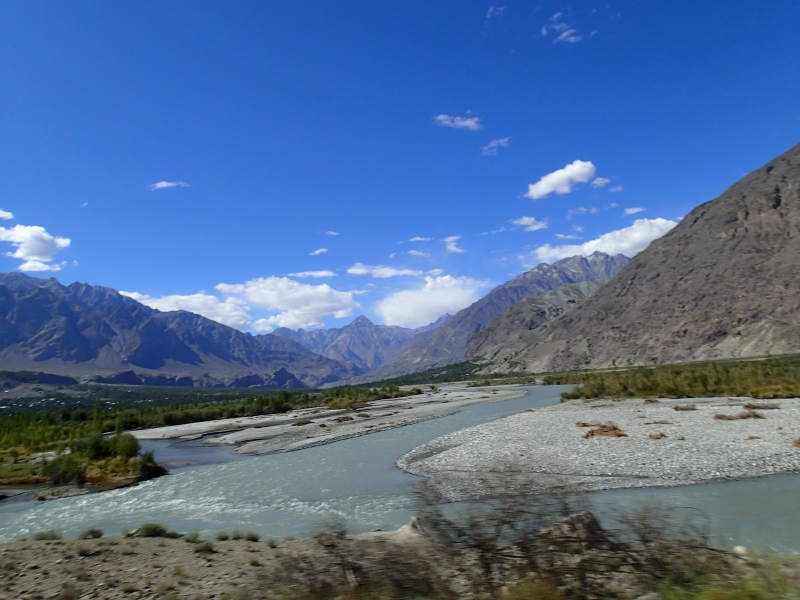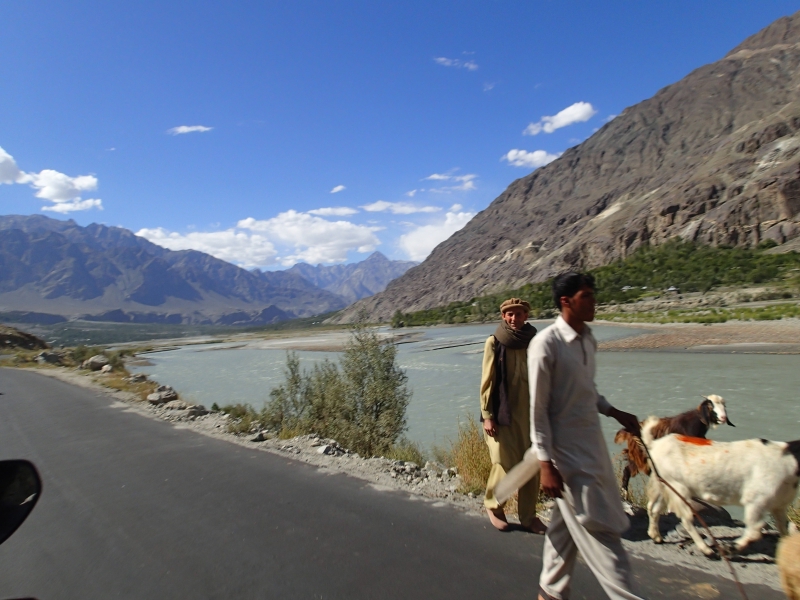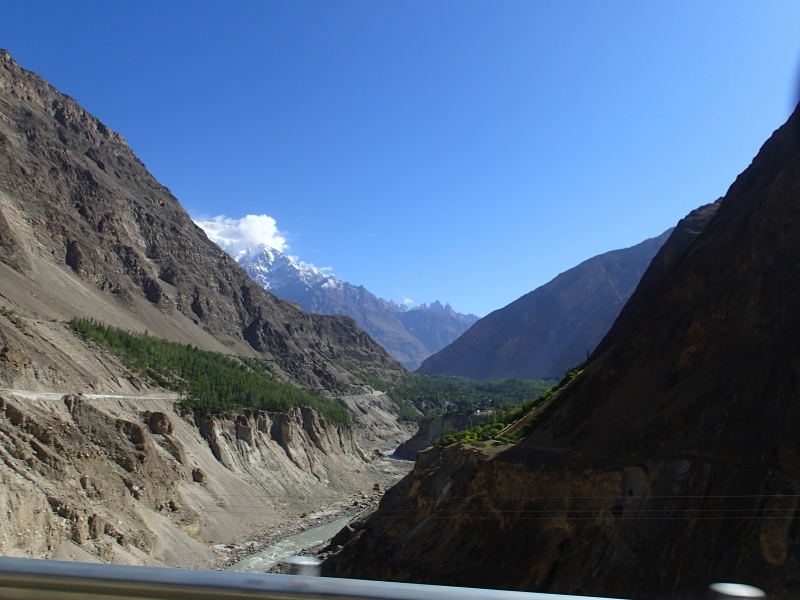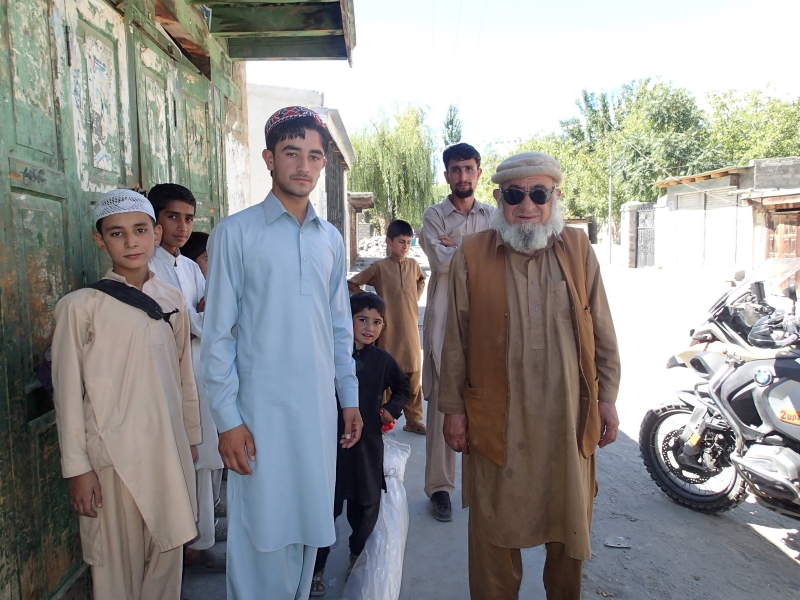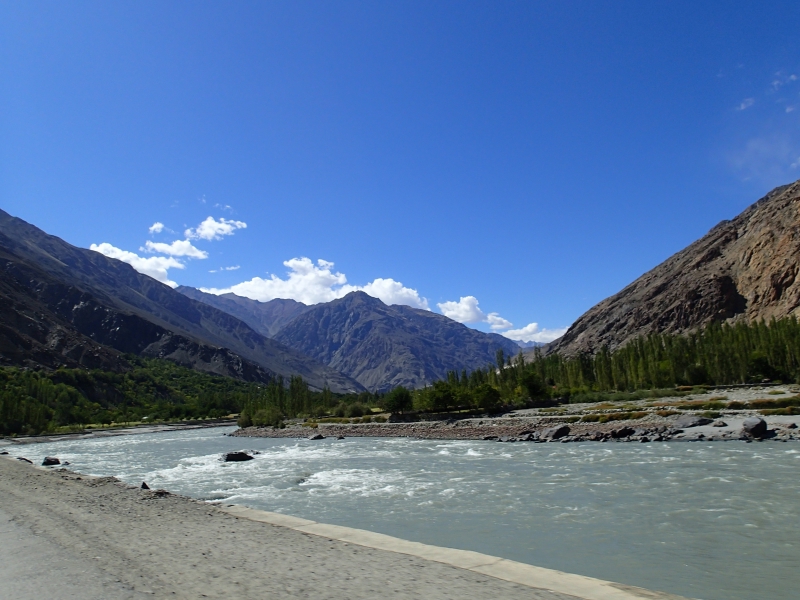Moin had advised against taking our R1200GSA two-up to Astore and Rama Lake via Skardu as the road was unsealed for a lot of the way and the last few km from Astore to Rama Lake is very steep and rocky, and instead suggested that we could take the Shandur-Gilgit Road west from Gilgit as far as Phander, as this road follows the scenic Gilgit River, at times level with the water, at times high up on the edge of cliffs overlooking the river far below.
We had an early breakfast at the Hunza View Hotel and said good bye to the U.S. riders on Moin’s tour, and his crew. Martin – the UK rider on the DR650’we had met in Passu a few days earlier – opted to come and see Phander with us, so our two bikes rolled out of the hotel about 08:45am.
The ride south from Hunza to Gilgit was very enjoyable – often riding the same road in the reverse direction reveals new sights to enjoy, and this southbound leg of the KKH didn’t disappoint. It was only about 110km from Hunza to Gilgit, but we took our time and enjoyed the scenery as we headed south.
Arriving at the outskirts of Gilgit we both refuelled, and then we stopped again in town so we could get some drinks and snacks. After a short break we headed off, aiming to pick up the Shandur-Gilgit Road that runs along the river, but it was difficult to determine where the main road went amidst all of the confusion of the morning markets, and it wasn’t too long before we stopped and Martin fired up his free map software to plot a route out of town.
The western edge of Gilgit gave way to small plots of corn and other crops, and children walking home from school, smartly dressed in their school uniforms. Moin had said that Phander – our intended destination for that evening – was four hours ride from Gilgit, and we made reasonable time over the single lane road, bouncing over the rocky, unsealed sections and peering over the cliff edges to look down at the river far below.
We had a couple of short stops early into the ride – one stop at a small shop so we could get something to drink, and a lot of local men and boys took great interest in us as we shared the lemonade, and then a short while later we stopped under the shade of some trees and a family of young, inquisitive children popped out from behind a tall gate and stared at us, so Karen made friends with them. They were quite shy and called their father, so we introduced ourselves to him, even though he spoke no English.
We encountered four or so police checkpoints along the way, alighting from our bikes and completing our passport and visa details in the record book. In one book I noticed the column heading “Purpose of Wizzet”.
The road twisted and turned alongside the river, occasionally running through avenues of trees. Karen observed that the scenery was quite similar to what we’d seen last year in Canada up in the Rockies – the wide river churning over the submerged rocks and creating islands of boulders midstream, with tall trees lining the river banks. In some places we saw narrow suspension bridges crossing the river and leading to small villages on the northern bank.
Arriving in Gupis the red warning light on the dashboard lit up, and the tyre pressure sensors indicated a flat rear tyre. I pulled off into a service station and reinflated the tyre with our electric pump, with Karen chasing off a group of boys that were crowding around me and the bike as I worked on it, but we had barely ridden a few hundred metres before the tyre was flat again.
We doubled back to a “tyre shop” but upon inspection it turned out to be a tailor’s shop, so a young man helped me find someone who explained that there was a tyre repair shop just across the bridge ahead. We crawled up to the shop – a little shack with a compressor and air hose and not much else, and Karen got straight to work – arranging with the men there to fix the tyre.
In the blink of an eye almost we had the wheel off the bike and the guys had spotted the puncture. Whilst they were repairing it with a plug we were being hassled by an officious police officer who had tracked us down and wanted to see our passports. He started demanding that we go to the local police station to report in, and I told him we’d go there once the bike was sorted out. He then wanted to take our passports but Karen insisted that wasn’t going to happen, so he finally left us, with instructions to attend the police station.
It didn’t take ten minutes for the tyre to be repaired and the wheel reinstalled on the bike. Karen asked the cost – 70PKR which she thought was too little so paid 400PKR, much to the owners dismay, as he tried to return the money but she refused. After a big round of “thank-you’s” we followed the owner of the tyre repair shop on his little 125 back to the police station. It’s worth noting that there was no checkpoint or road barrier in this little village and hence no indication that we needed to stop and report in, but we followed the tyre guy off the main road and down a steep track to the police compound.
We didn’t see the arrogant and rude policeman again, but instead met a dozen or so very polite and courteous policemen inside the compound. Karen waited in the outer compound with the motorbikes whilst Martin and I completed the passport entries, and as Karen waited she smooth-talked to the officer-in-charge, so shortly afterwards we were invited into his office to enjoy a cold cup of fanta and a chat with one of the policemen there, who was very keen to hear about our travels, and to chat about his family and his work. He was particularly impressed with the crisp salute that Martin had given the policemen a short while earlier, as they only received nine months training and hadn’t mastered a proper salute in that time.
After our drinks we said our farewells – many of the police were now preoccupied with the arrival of some less salubrious guests in the back of two police wagons – and rode off, thankfully with the tyre retaining pressure.
Signs indicated that Phander was another 55km or so down the road and the sun was starting to drop behind the high valley peaks, so I was pleased when Martin stopped at the PTDC Motel in Jandrot (just west of Gupis) and suggested we call it a day. At the rate we were travelling we wouldn’t have made Phander in daylight and riding these roads at night would have been foolhardy, and in addition we were all tired from our long day.
The Jandrot PTDC Motel was like a European hunting lodge, with high wooden ceilings, and our rooms were basic but functional, and the showers were hot. We unpacked, showered, and then enjoyed a delicious dinner of dodo soup, chicken jalfrezi, chicken biryani and chappatis. We were all exhausted and were in bed by about 08:30pm – it had been a long day, and though Phander had proven to be a bridge too far, we had all enjoyed our adventurous day.

